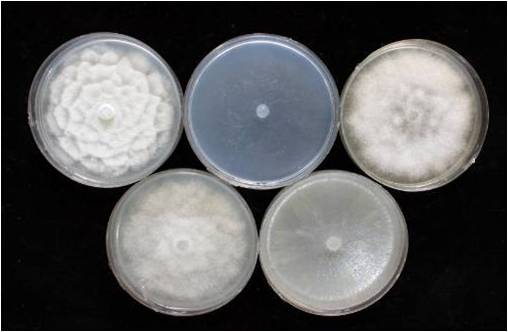Phytophthora pseudocryptogea
|
Phytophthora spp. in subclade 8a: portion of the seven-loci ML phylogeny featuring the type cultures of 212 described species (by T. Bourret). Notice the position of P. pseudocryptogea Ex-type CBS 139749 = S&T BL 183. Gloria Abad, USDA S&T.
|
|
Phytophthora spp. in subclade 8a: Morphological Tabular key (PDF) and Tabular key legends (PDF) in IDphy2 KEY SECTION. Notice the data of P. pseudocryptogea Ex-type CBS 139749 = S&T BL 183. Gloria Abad, USDA S&T.
|
|
|
|
|
|
|
Name and publication
Phytophthora pseudocryptogea Safaief., Mostowf., G.E. Hardy & T.I. Burgess (2015)
Safaiefarahani B, Mostowfizadeh-Ghalamfarsa R, Hardy GE StJ, and Burgess TI. 2015. Re-evaluation of the Phytophthora cryptogea species complex and the description of a new species, Phytophthora pseudocryptogea sp. nov. Mycol Progress 14: 1–12.
Corresponding author: R. Mostowfizadeh-Ghalamfarsa; rmostofi@shirazu.ac.ir
Nomenclature
from Safaiefarahani et al. (2015)
Mycobank
Etymology
refers to morphological and physiological resemblance of this species to Phytophthora cryptogea
Typification
Type: AUSTRALIA, Western Australia, Fitzgerald River National Park from roots of dying Isopogon buxifolius, September 2006; collected by Department of Parks and Wildlife. MURU471
Ex-type: CBS 139749 = VHS 16118
Sequences for Ex-type: Phytophthora pseudocryptogea isolate VHS 16118 = ITSrDNA KP288376, β-tubulin KP288392, Elicitin KP288410, HSP90 KP288426, NADHI KP288360, CoxI KP288342
Ex-type in other collections
(ET) CBS 139749, VHS16118, S&T BL 183 (Abad)
Molecular identification
Voucher sequences for barcoding genes (ITS rDNA and COI) of the ex-type (see Molecular protocols page)
Phytophthora pseudocryptogea isolate VHS 16118 ITS rDNA KP288376
Phytophthora pseudocryptogea isolate CPHST BL 183 (= VHS 16118) COI MH477756
Sequences of selected specimen
Phytophthora pseudocryptogea isolate CPHST BL 139 (= P1380 WPC) = ITS rDNA MG865572, COI MH136964
Voucher sequences for Molecular Toolbox with seven genes (ITS, β-tub, COI, EF1α, HSP90, L10, and YPT1
(see Molecular protocols page) (In Progress)
Voucher sequences for Metabarcoding High-throughput Sequencing (HTS) Technologies [Molecular Operational Taxonomic Unit (MOTU)]
(see Molecular protocols page) (In Progress)
Sequences with multiple genes for ex-type in other sources
- NCBI: Phytophthora pseudocryptogea CPHST BL 183
- NCBI: Phytophthora pseudocryptogea VHS 16118
- EPPO-Q-bank: Phytophthora pseudocryptogea
- BOLDSYSTEMS: Phytophthora pseudocryptogea
Position in multigenic phylogeny with 7 genes (ITS, β-tub, COI, EF1α, HSP90, L10, and YPT1)
Clade 8a
Morphological identification
Colonies and cardinal temperatures
Colony colony:
assemblage of hyphae which usually develops form a single source and grows in a coordinated way
morphology after 7 days at 20 °C was rosoid to chrysanthemum on V8A, CA, MEA, and PDA, and uniform on CMA. Minimum growth temperature 3°C, maximum 35°C, and optimum 25°C.
Asexual phase
SporangiaSporangia:
sac within which zoospores form, especially when water is cooled to about 10°C below ambient temperature; in solid substrates, sporangia usually germinate by germ tubes
nonpapillatenonpapillate:
pertaining to the production of a non-distinct, or inconspicuous, papilla at the distal end of the sporangium (cf. papillate and semipapillate)
, persistentpersistent:
pertaining to sporangia that remain attached to the sporangiophore and do not separate or detach easily (cf. caducous)
, terminal, ovoidovoid:
egg-shaped, with the widest part at the base of the sporangium and the narrow part at the apex
, ellipsoidellipsoid:
refers to a solid body that forms an ellipse in the longitudinal plane and a circle in cross section; many fungal spores are ellipsoidal or elliptic
to pyriformpyriform:
pear-shaped, with the narrowest part at the base (cf. obpyriform)
, 43.6 ± 5.9 × 27.4 ± 3.3 μm, length/width ratio is 1.59. Sporangiophores simple and unbranched. Hyphal swellings globoseglobose:
having a rounded form resembling that of a sphere
to irregular. ChlamydosporesChlamydospores:
an asexual spore with a thickened inner wall that is delimited from the mycelium by a septum; may be terminal or intercalary, and survives for long periods in soil
absent.
Sexual phase
Heterothallicheterothallic:
pertaining to sexual reproduction in which conjugation is possible only through interaction of different thalli (i.e. different mating types) (cf. homothallic)
. OogoniaOogonia:
the female gametangium in which the oospore forms after fertilization by the antheridium
globoseglobose:
having a rounded form resembling that of a sphere
and averaged 34 ± 3.8 μm diam. AntheridiaAntheridia:
the male gametangium; a multinucleate, swollen hyphal tip affixed firmly to the wall of the female gametangium (the oogonium)
amphigynousamphigynous:
pertaining to the sexual stage in which the antheridium completely surrounds the stalk of the oogonium (cf. paragynous)
. OosporesOospores:
zygote or thick-walled spore that forms within the oogonium after fertilization by the antheridium; may be long-lived
apleroticaplerotic:
pertaining to a mature oospore that does not fill the oogonium; i.e. there is room left between the oospore wall and oogonium wall (cf. plerotic)
to nearly pleroticplerotic:
pertaining to an oospore that fills the oogonium (cf. aplerotic)
, 30.1 ± 4.1 μm diam.
Most typical characters
All morphological features of P. pseudocryptogea overlap with those of P. erythroseptica, P. cryptogea and P. sp. kelmania (except that P. erythroseptica is homothallichomothallic:
pertaining to sexual reproduction that can take place within a single thallus (i.e. self-fertile, non-outcrossing) (cf. heterothallic).
).
Specimen(s) evaluated
Phytophthora pseudocryptogea CBS 139749 (Centraalbureau von Schimmelcultures)
Phytophthora pseudocryptogea SUC 620 (Iran)
Phytophthora pseudocryptogea SUC 633 (Iran)
Phytophthora pseudocryptogea VHS 5380 (Vegetation Health Service, Department of Parks and Wildlife, Western Australia)
Phytophthora pseudocryptogea DDS 3612 (Vegetation Health Service, Department of Parks and Wildlife, Western Australia)
Hosts and distribution
Distribution: Asia (Iran), Australia, South America (Ecuador)
Substrate: roots, soil
Disease note: root rot
Host: Banksia cirsioides (Proteaceae), Solanum melongena (Solanaceae), Xanthorrhoea preissii (Asphodelaceae)
Retrieved February 01, 2018 from U.S. National Fungus Collections Nomenclature Database.
Additional info:
Hosts: Isopogon buxifolius
Additional references and links
- SMML USDA-ARS: Phytophthora pseudocryptogea
- EPPO Global Database: Phytophthora pseudocryptogea
- Forest Phytophthora of the world: Phytophthora pseudocryptogea
- CABI Digital Library: Phytophthora pseudocryptogea
- Encyclopedia of Life (EOL): Phytophthora pseudocryptogea
- Index Fungorum (IF): Phytophthora pseudocryptogea
- Google All Phytophthora pseudocryptogea
- Google Images Phytophthora pseudocryptogea
- Google Scholar Phytophthora pseudocryptogea
Fact sheet authors
Treena Burgess, Ph.D., Phytophthora Science and Management, Harry Butler Institute, Murdoch University, Australia
Z. Gloria Abad, Ph.D., USDA-APHIS-PPQ-S&T Plant Pathogen Confirmatory Diagnostics Laboratory (PPCDL), United States of America.




